Balbharti Maharashtra State Board Class 8 History Solutions
Chapter 11 Struggle for Equality Notes, Textbook Exercise Important Questions and Answers.
Class 8 History Chapter 11 Struggle for Equality Textbook Questions and Answers
1. Rewrite the statements by- choosing the appropriate options:
(Lala Lajpat Rai, Sane Guruji, Dr. Rakhmabai Janardan Save, Deenbandhu Mitra, Babasaheb Bole)
Question 1.
…………….. founded the Red Cross Society at Rajkot.
Answer:
Dr. Rakhmabai Janardan Save
Question 2.
…………….. was the president of mill workers union at Ammalner.
Answer:
Sane Guruji
Question 3.
The president of the first session of AITUC was ……………..
Answer:
Lala Lajpat Rai
2. Write short notes:
Question 1.
Social Work of Maharshi Vitthal Ramji Shinde :
Answer:

Question 2.
Reforms of Rajarshi Shahu Maharaj in the state of Kolhapur :
Answer:
3. Explain the following statements with reasons:
Question 1.
The Government decided to crush down the Communist movement.
Answer:
Question 2.
Dr. Babasaheb Ambedkar started newspapers like ‘Muknayak’, ‘Bahishkrut Bharat’, etc.
Answer:

Question 3.
There aroused a need of a nationwide workers union.
Answer:
Therefore, a necessity was felt for a nationwide worker union.
4. Answer the following questions in brief:
Question 1.
Why was the struggle for equality important in the making of Modern India?
Answer:
This proves that the struggle for equality has great significance in the making of Modern India.
Question 2.
Write about the work of Sane Guruji in eastern Khandesh.
Answer:

Question 3.
How was the struggle built up by the workers decisive for the national movement?
Answer:
Question 4.
Discuss the nature of reform movement related to women.
Answer:
Do you Know?
Narayan Meghaji Lokhande:
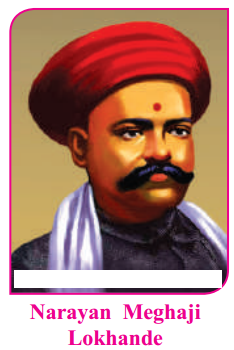
The native place of Narayan Meghaji Lokhande was Kanhesar near Saswad in Pune district.

Dr. Anandibai Joshi:
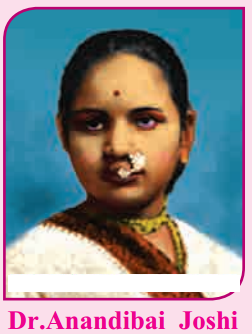
Project:
Question 1.
Read the biography of Dr. Anandibai Joshi.
Question 2.
Read the biography of Rajarshi Shahu Maharaj.
Class 8 History Chapter 11 Struggle for Equality Additional Important Questions and Answers
Rewrite the statements by- choosing the appropriate options :
Question 1.
……………. got a bill passed in the Bombay Provincial Assembly for the public water reservoirs to be opened to the untouchable.
Answer:
Babasaheb Bole
Question 2.
Neel Darpan written by …………….. brought to notice of the society wretched conditions of the peasants.
Answer:
Deenbandhu Mitra.
Name the following:
Question 1.
Through the magazine ‘Somavanshiya Mitra’ raised voice regarding issues of Muralis and Jogtins.
Answer:
Shivram Janbci Kamble
Question 2.
Chairman of Mumbai branch of Satyashodhak Samaj.
Answer:
Narayan Meghaji Lokhande
Question 3.
Movement of eradication of untouchability in Tamil Nadu
Answer:
Perriyar Ramaswamy
Question 4.
Active in international Communist Movement.
Answer:
Manavendranath Roy

Question 5.
Baba Ramachandra.
Answer:
Baba Ramchandra.
Rewrite the statements by choosing the appropriate options:
Question 1.
…………….. was the president of ‘Akhil Bharatiya Kisan Sabha’
(a) Sane Guruji
(b) Swami Sahajananda Saraswati
(c) Maharshi Vitthal Ramji Shinde
(d) Manavendranath Roy
Answer:
(b) Swami Sahajananda Saraswati
Question 2.
The session of the Congress was held in the rural part of …………… in Maharashtra.
(a) Nagpur
(b) Baramati
(c) Faizpur
(d) Miraj
Answer:
(c) Faizpur
Question 3.
……………… went on fast unto death to open the doors of Vitthal temple at Pandharpur for the Dalits,
(a) Sane Guruji
(b) Dr. Babasaheb Ambedkar
(c) Karmaveer Dadasaheb Gaikwad
(d) Babasaheb Bole
Answer:
(a) Sane Guruji

Question 4.
Due to efforts of …………….., the workers started getting weekly holiday on Sunday from 10 June, 1890.
(a) Shripad Amrut Dange
(b) Shashipad Banerjee
(c) Lala Lajpat Rai
(d) Narayan Meghaji Lokhande
Answer:
(d) Narayan Meghaji Lokhande
Question 5.
In 1881, …………….. wrote an article on Marx.
(a) Dr. Rammanohar Lohia
(b) Lokmanya Tilak
(c) Mahatma Gandhi
(d) Shripad Amrut Dange
Answer:
(b) Lokmanya Tilak
Question 6.
Condemned untouchability through his book ‘Vital Vidhwansan’
(a) Gopal Baba Walangkar
(b) Shivram Janba Kamble
(c) Thakkar Bappa
(d) Appasaheb Patwardhan
Answer:
(a) Gopal Baba Walangkar
Question 7.
Karmaveer Dadasaheb Gaikwad led Satyagraha for entry of Dalits in
(a) Kalaram temple
(b) Vitthal temple
(c) Parvati temple
(d) Bhavani temple
Answer:
(a) Kalaram temple

Question 8.
…………….. passed the Act of inter-caste marriage and gave it a legal acceptance in the state of Kolhapur.
(a) Mahatma Jyotirao Phule
(b) Rajarshi Shahu Maharaj
(c) Rajaram Maharaj
(d) Maharshi Vitthal Ramji Shinde
Answer:
(b) Rajarshi Shahu Maharaj
Answer the following questions in one sentence:
Question 1.
State the significance of ‘Neel Darpan’
Answer:
Deenbandhu Mitra in his play ‘Neel Darpan’ brought to the notice of the society the wretched conditions of the peasants who were forced to cultivate indigo.
Question 2.
What was the important work done by ‘Akhil Bharatiya Kisan Sabha’?
Answer:
The Akhil Bharatiya Kisan Sabha’ presented a declaration of peasants’ rights to the Indian National Congress.
Question 3.
What message did Lala Lajpat Rai give to the workers in the first session of AITUC?
Answer:
At the first session of AITUC Lala Lajpat Rai asked the workers to actively participate in the national movement.
Question 4.
Why did Dr. Ambedkar and his followers embrace Buddhism?
Answer:
Dr. Ambedkar and his followers embraced Buddhism as it advocated humanity and equality. ‘
Question 5.
Which institutions were founded by Pandita Ramabai?
Answer:
Pandita Ramabai had founded the ‘Arya Mahila Samaj’ and ‘Sharda Sadan’.

Question 6.
What message did Dr. Babasaheb Ambedkar give his followers?
Answer:
Dr. Babasaheb Ambedkar gave the inspirational message,’Be Educated, Be Organised and Be Agitated’ to his followers.
Do as Directed:
Complete the Concept Map:
Question 1.
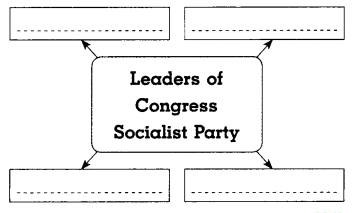
Answer:
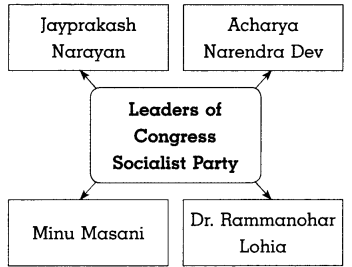
Question 2.
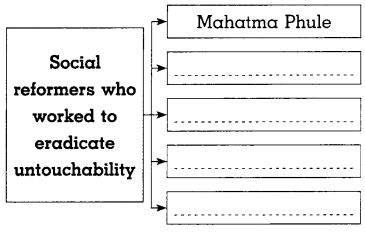
Answer:
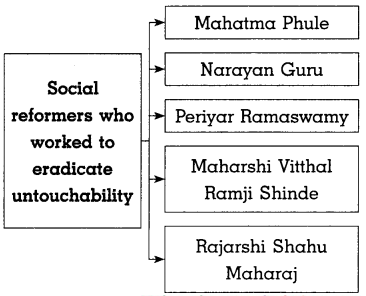
Question 3.
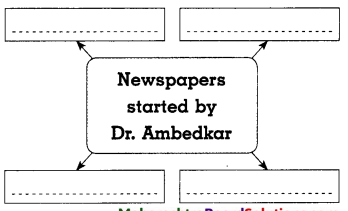
Answer:
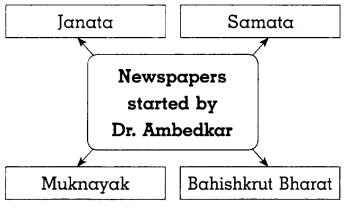
Complete the following table:
Question 1.
Answer:
Write short notes:
Question 1.
The Meerut Conspiracy Case:
Answer:

Question 2.
Work of Rakhmabai Janardan Save:
Answer:
Explain the following statements with reasons:
Question 1.
Narayan Meghaji Lokhande is described as ‘Father of Indian Workers Movement’.
Answer:
Thus, his contribution to the working-class movement was so valuable that he is described as ‘Father of Indian Workers Movement’.
Question 2.
The Congress Socialist Party was formed in 1934.
Answer:
Answer the following questions in brief:
Question 1.
Write about the work of Rajarshi Shahu Maharaj for abolition of caste distinction.
Answer:
The following work was done by Rajarshi Shahu Maharaj in his state of Kolhapur for abolition of caste distinction:

Question 2.
Explain the objectives of Dr. Babasaheb Ambedkar in launching the Dalit movement.
Answer:
The objectives of Dr. Babasaheb Ambedkar in launching the Dalit movement 5 is as follows:
Question 3.
Write about the work done by Mahatma Gandhi for eradication of untouchability.
Answer:
Answer the following in detail:
Question 1.
Give a brief account of the peasant’s movement during the pre-independence movement.
Answer:

Question 2.
Write information about the workers’ movement in the pre-independence movement.
Answer:
Question 3.
Write about the development in the Dalit movement.
Answer:
Question 4.
What work was done for development of workers and Dalits by Dr. Babasaheb Ambedkar?
Answer:
The following work was done by Dr. Babasaheb Ambedkar for the development of workers and Dalits:

Question 5.
Identify the given incident depicted in the picture and write information on it.
image
Answer:
Question 6.
Why do you feel the structure of the society should be based on equality?
Answer:
Chapter 11 Struggle for Equality Notes, Textbook Exercise Important Questions and Answers.
Class 8 History Chapter 11 Struggle for Equality Textbook Questions and Answers
1. Rewrite the statements by- choosing the appropriate options:
(Lala Lajpat Rai, Sane Guruji, Dr. Rakhmabai Janardan Save, Deenbandhu Mitra, Babasaheb Bole)
Question 1.
…………….. founded the Red Cross Society at Rajkot.
Answer:
Dr. Rakhmabai Janardan Save
Question 2.
…………….. was the president of mill workers union at Ammalner.
Answer:
Sane Guruji
Question 3.
The president of the first session of AITUC was ……………..
Answer:
Lala Lajpat Rai
2. Write short notes:
Question 1.
Social Work of Maharshi Vitthal Ramji Shinde :
Answer:

Question 2.
Reforms of Rajarshi Shahu Maharaj in the state of Kolhapur :
Answer:
3. Explain the following statements with reasons:
Question 1.
The Government decided to crush down the Communist movement.
Answer:
Question 2.
Dr. Babasaheb Ambedkar started newspapers like ‘Muknayak’, ‘Bahishkrut Bharat’, etc.
Answer:

Question 3.
There aroused a need of a nationwide workers union.
Answer:
Therefore, a necessity was felt for a nationwide worker union.
4. Answer the following questions in brief:
Question 1.
Why was the struggle for equality important in the making of Modern India?
Answer:
This proves that the struggle for equality has great significance in the making of Modern India.
Question 2.
Write about the work of Sane Guruji in eastern Khandesh.
Answer:

Question 3.
How was the struggle built up by the workers decisive for the national movement?
Answer:
Question 4.
Discuss the nature of reform movement related to women.
Answer:
Do you Know?
Narayan Meghaji Lokhande:

The native place of Narayan Meghaji Lokhande was Kanhesar near Saswad in Pune district.

Dr. Anandibai Joshi:

Project:
Question 1.
Read the biography of Dr. Anandibai Joshi.
Question 2.
Read the biography of Rajarshi Shahu Maharaj.
Class 8 History Chapter 11 Struggle for Equality Additional Important Questions and Answers
Rewrite the statements by- choosing the appropriate options :
Question 1.
……………. got a bill passed in the Bombay Provincial Assembly for the public water reservoirs to be opened to the untouchable.
Answer:
Babasaheb Bole
Question 2.
Neel Darpan written by …………….. brought to notice of the society wretched conditions of the peasants.
Answer:
Deenbandhu Mitra.
Name the following:
Question 1.
Through the magazine ‘Somavanshiya Mitra’ raised voice regarding issues of Muralis and Jogtins.
Answer:
Shivram Janbci Kamble
Question 2.
Chairman of Mumbai branch of Satyashodhak Samaj.
Answer:
Narayan Meghaji Lokhande
Question 3.
Movement of eradication of untouchability in Tamil Nadu
Answer:
Perriyar Ramaswamy
Question 4.
Active in international Communist Movement.
Answer:
Manavendranath Roy

Question 5.
Baba Ramachandra.
Answer:
Baba Ramchandra.
Rewrite the statements by choosing the appropriate options:
Question 1.
…………….. was the president of ‘Akhil Bharatiya Kisan Sabha’
(a) Sane Guruji
(b) Swami Sahajananda Saraswati
(c) Maharshi Vitthal Ramji Shinde
(d) Manavendranath Roy
Answer:
(b) Swami Sahajananda Saraswati
Question 2.
The session of the Congress was held in the rural part of …………… in Maharashtra.
(a) Nagpur
(b) Baramati
(c) Faizpur
(d) Miraj
Answer:
(c) Faizpur
Question 3.
……………… went on fast unto death to open the doors of Vitthal temple at Pandharpur for the Dalits,
(a) Sane Guruji
(b) Dr. Babasaheb Ambedkar
(c) Karmaveer Dadasaheb Gaikwad
(d) Babasaheb Bole
Answer:
(a) Sane Guruji

Question 4.
Due to efforts of …………….., the workers started getting weekly holiday on Sunday from 10 June, 1890.
(a) Shripad Amrut Dange
(b) Shashipad Banerjee
(c) Lala Lajpat Rai
(d) Narayan Meghaji Lokhande
Answer:
(d) Narayan Meghaji Lokhande
Question 5.
In 1881, …………….. wrote an article on Marx.
(a) Dr. Rammanohar Lohia
(b) Lokmanya Tilak
(c) Mahatma Gandhi
(d) Shripad Amrut Dange
Answer:
(b) Lokmanya Tilak
Question 6.
Condemned untouchability through his book ‘Vital Vidhwansan’
(a) Gopal Baba Walangkar
(b) Shivram Janba Kamble
(c) Thakkar Bappa
(d) Appasaheb Patwardhan
Answer:
(a) Gopal Baba Walangkar
Question 7.
Karmaveer Dadasaheb Gaikwad led Satyagraha for entry of Dalits in
(a) Kalaram temple
(b) Vitthal temple
(c) Parvati temple
(d) Bhavani temple
Answer:
(a) Kalaram temple

Question 8.
…………….. passed the Act of inter-caste marriage and gave it a legal acceptance in the state of Kolhapur.
(a) Mahatma Jyotirao Phule
(b) Rajarshi Shahu Maharaj
(c) Rajaram Maharaj
(d) Maharshi Vitthal Ramji Shinde
Answer:
(b) Rajarshi Shahu Maharaj
Answer the following questions in one sentence:
Question 1.
State the significance of ‘Neel Darpan’
Answer:
Deenbandhu Mitra in his play ‘Neel Darpan’ brought to the notice of the society the wretched conditions of the peasants who were forced to cultivate indigo.
Question 2.
What was the important work done by ‘Akhil Bharatiya Kisan Sabha’?
Answer:
The Akhil Bharatiya Kisan Sabha’ presented a declaration of peasants’ rights to the Indian National Congress.
Question 3.
What message did Lala Lajpat Rai give to the workers in the first session of AITUC?
Answer:
At the first session of AITUC Lala Lajpat Rai asked the workers to actively participate in the national movement.
Question 4.
Why did Dr. Ambedkar and his followers embrace Buddhism?
Answer:
Dr. Ambedkar and his followers embraced Buddhism as it advocated humanity and equality. ‘
Question 5.
Which institutions were founded by Pandita Ramabai?
Answer:
Pandita Ramabai had founded the ‘Arya Mahila Samaj’ and ‘Sharda Sadan’.

Question 6.
What message did Dr. Babasaheb Ambedkar give his followers?
Answer:
Dr. Babasaheb Ambedkar gave the inspirational message,’Be Educated, Be Organised and Be Agitated’ to his followers.
Do as Directed:
Complete the Concept Map:
Question 1.

Answer:

Question 2.

Answer:

Question 3.

Answer:

Complete the following table:
Question 1.
| Founder | Organisation/ Institution |
| 1. Maharshi Vitthal Ramji Shinde | ………………………………………… |
| 2. ………………………………. | Akhil Bharatiya Kisan Sabha |
| 3. Ramabai Ranade | ………………………………………… |
| 4. ……………………………….. | Independent Labour Party |
| Founder | Organisation/ Institution |
| 1. Maharshi Vitthal Ramji Shinde | Depressed Classes Mission |
| 2. Prof. N.G. Ranga | Akhil Bharatiya Kisan Sabha |
| 3. Ramabai Ranade | Seva Sadan institution |
| 4. Dr. Babasaheb Ambedkar | Independent Labour Party |
Question 1.
The Meerut Conspiracy Case:
Answer:

Question 2.
Work of Rakhmabai Janardan Save:
Answer:
Explain the following statements with reasons:
Question 1.
Narayan Meghaji Lokhande is described as ‘Father of Indian Workers Movement’.
Answer:
Thus, his contribution to the working-class movement was so valuable that he is described as ‘Father of Indian Workers Movement’.
Question 2.
The Congress Socialist Party was formed in 1934.
Answer:
Answer the following questions in brief:
Question 1.
Write about the work of Rajarshi Shahu Maharaj for abolition of caste distinction.
Answer:
The following work was done by Rajarshi Shahu Maharaj in his state of Kolhapur for abolition of caste distinction:

Question 2.
Explain the objectives of Dr. Babasaheb Ambedkar in launching the Dalit movement.
Answer:
The objectives of Dr. Babasaheb Ambedkar in launching the Dalit movement 5 is as follows:
Question 3.
Write about the work done by Mahatma Gandhi for eradication of untouchability.
Answer:
Answer the following in detail:
Question 1.
Give a brief account of the peasant’s movement during the pre-independence movement.
Answer:

Question 2.
Write information about the workers’ movement in the pre-independence movement.
Answer:
Question 3.
Write about the development in the Dalit movement.
Answer:
Question 4.
What work was done for development of workers and Dalits by Dr. Babasaheb Ambedkar?
Answer:
The following work was done by Dr. Babasaheb Ambedkar for the development of workers and Dalits:

Question 5.
Identify the given incident depicted in the picture and write information on it.
image
Answer:
Question 6.
Why do you feel the structure of the society should be based on equality?
Answer: